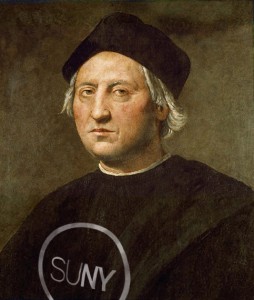
The United States joins other American nations in celebrating Columbus Day this weekend as we celebrate the discovery of the “New World” by Christopher Columbus on October 12, 1492. Workers take the day off from their job and students get an extra day off. But what if Christopher Columbus was a student in the new world and in New York? Where would he go to college?
We believe the answer is SUNY — and have come up with 5 arguments to support that assertion. Read past the jump to see!

Columbus made four voyages to the New World.
Although best known for his historic 1492 expedition, Columbus returned to the Americas three more times in the following decade. His voyages took him to Caribbean Islands, South America and Central America.
So what does this have to do with SUNY? Well, SUNY enrolls students from over 160 countries, including from all four areas that Mr. Columbus landed on!
Columbus never actually stepped foot on the mainland of North America.
But if he did, there’s a chance that he could have touched a SUNY campus (albeit small!).
Columbus did not have a photographer on-board any of his ships.
This is why we see drawings depict the trips! And we Millennials may find it hard to believe, but this would have been impossible; the first camera, which was huge, was invented in the 16th Century — over 50 years after the expeditions.
But in the 21st Century, SUNY impacts nearly every artistic medium, including photography!
A lunar eclipse may have saved Columbus.
In February 1504, a desperate Columbus was stranded in Jamaica, abandoned by half his crew and denied food by the islanders. Knowing from his almanac that a lunar eclipse was coming later that month, he warned the islanders that his god was upset with their refusal of food and that the moon would “rise inflamed with wrath” as an expression of divine displeasure. When the eclipse did, in fact, occur, the terrified islanders offered provisions and beseeched Columbus to ask his god for mercy.
Thanks to SUNY’s massive amount of resources, we can next time make a phone call to SUNY New Paltz’s Physics and Astronomy experts in order to best lead (or, mislead) our crew back home!
Historians aren’t sure if Columbus knew that he struck new land.
Even near the time of his death, Mr. Columbus told the Pope that he truly believed that the land he struck was the easternmost portions of Asia. Some historians have since refuted this — saying that he knew the land was unique because of the explicit names for the land — but we may never be sure.
Lucky for us, SUNY boasts expert geographers that specialize in navigation and mapping — and some who could work side-by-side with SUNY Maritime College!
Christopher Columbus wasn’t his real name.
Christopher Columbus is an Anglicization of his real name, which was Cristoforo Colombo, given to him in his home country of Genoa. And English-speakers aren’t along; other languages have changed his name, too. In Spanish, his name is Cristóbal Colón iin Swedish, it’s Kristoffer Kolumbus.
SUNY is a powerful presence, and although SUNY is also known by 64 other names, the four letters remain constant no matter where the campus is — Incheon, South Korea or Canton, New York! So, if Mr. Columbus has a federal trademarked name, too, then he probably wouldn’t have run into the whole “what’s his name?” problem.
Photo: SUNY Maritime

